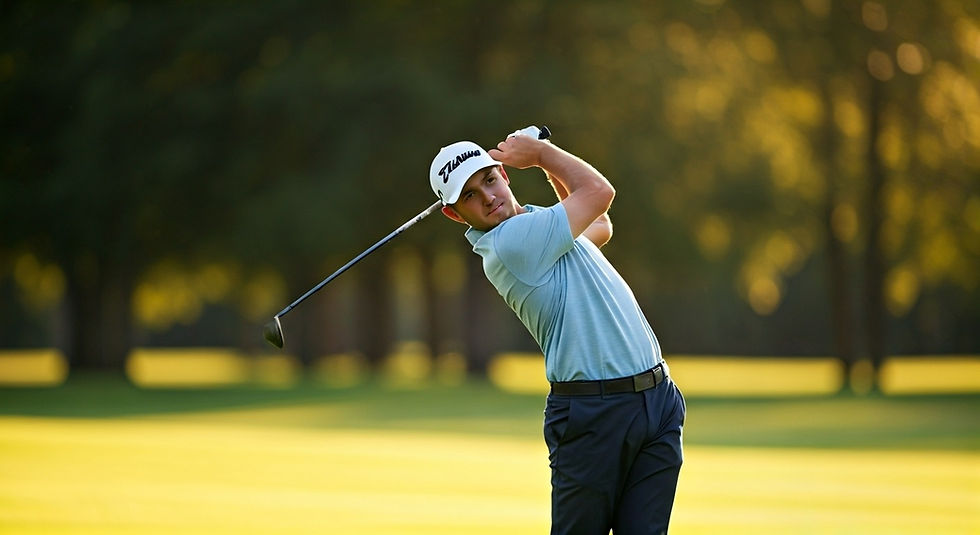Inside The Mind: How Pro Golfers Prepare for Ryder Cup Pressure
- Dr Paul McCarthy

- Sep 18
- 8 min read

Mental preparation at the Ryder Cup starts well before players reach that first tee. They face what many professionals call the most intense pressure in sports. This tournament between Europe and the United States tests more than just golfing skills. Players ended up proving themselves when pressure peaks.
Professional golfers tell me that Ryder Cup pressure surpasses the tension they experience in major championships. Players need more than just knowledge of rules and format. Champions stand apart through their psychological mindset. Fans track ryder cup 2023 live scores without seeing the mental strategies unfolding backstage. The ryder cup scoring method remains a crossword puzzle to casual followers. It shows the results of an intense mental game that starts with specific techniques. Some professionals use 10-minute breathing exercises before each round to prepare.
What makes Ryder Cup pressure so intense
The Ryder Cup creates a pressure cooker environment that rattles even the most composed golfers, unlike regular tournaments. Lee Janzen, a former Ryder Cup player, captured it perfectly: "You're playing for your team. You're playing for your country. The weight of all of it... it just makes for a great week." [1]
Team format vs. individual play
Professional golfers spend their careers competing alone, usually trying to beat 155 other players in tournaments. The Ryder Cup's team format changes everything. Each shot affects your team's fate, not just your own score. Padraig Harrington put it well: "You're worried about letting your partner down in the first four sessions. You're worried about letting Europe down." [2]
Players must adapt to completely different competitive mindsets. The format adds extra pressure through fourball and foursomes matches that need mutually beneficial alliances, while singles matches carry the team's expectations.
Crowd energy and national pride
Golf has never seen atmosphere like the Ryder Cup. Players describe it as "a cauldron of passion and unbridled enthusiasm" [3] as thousands of fans in national colors pack the course. The partisan crowd creates thunderous roars that echo down fairways, and every putt draws explosive reactions.
Players compete purely for pride, their teammates, and their fans - not prize money [4]. Team Europe has started training with VR headsets that play recorded insults to prepare for hostile American crowds at Bethpage Black. Rory McIlroy explained it simply: "It is just to simulate the sights and sounds and noise. That's the stuff that we are going to have to deal with." [5]
The weight of expectations
History adds more pressure to the mix. American teams have won only two Ryder Cups since their miraculous comeback at Brookline in 1999 [4]. Their disappointing 3-9 record since 1995 has put enormous pressure on Team USA.
The emotional impact shows clearly in players' reactions. Rory McIlroy's tearful interview after his singles match says it all: "I love being a part of this team... I love my teammates so much, and I should've done more for them this week." [4]
No other golf competition matches this unique blend of team responsibility, nationalist passion, and historical significance. The pressure stands alone.
Mental strategies pros use to stay focused
Professional golfers excel at specific mental techniques that help them perform their best during high-stakes moments. These strategies are the foundations of effective Ryder Cup mental preparation. A player's mental toughness often decides the outcome more than their technical abilities.
Breathing techniques to calm nerves
The best golfers use controlled breathing to handle their emotions and stay focused under pressure. The 4-4-4-4 box breathing technique works well. Players breathe in for four seconds, hold for four, breathe out for four, then pause for four more. This method helps steady the nervous system and slows down the heart rate [6]. The 4-7-8 technique helps players reduce tension before vital putts [6]. The right breathing pattern also helps physical performance. Research shows that breathing in during backswing and follow-through while breathing out during downswing gives the best power transfer [7].
Visualization and mental rehearsal
Jack Nicklaus credited 50% of his success to visualization [8]. This powerful method triggers the same brain pathways as actually making the shot [9]. The best visualization involves all senses - players see the ball's path, feel their swing motion, and hear the club strike [9]. Players find better results by practicing this technique in their setup position instead of a relaxed state. This creates a more realistic mental picture [10].
Using pre-shot routines for consistency
Research shows the quickest way to execute a pre-shot routine takes eight seconds or less from stance to swing [11]. The world's best players develop reliable processes that combine decision-making, visualization, practice swings, and proper setup [12]. These routines work like mental anchors that keep players focused whatever the ryder cup scoring method or pressure situation. A dependable pre-shot process acts like having your own caddie [11].
Blocking out distractions on the course
The best players accept things beyond their control - weather, crowd noise, or how their opponents play [13]. Success comes from splitting attention between "shot time" and "between shot time" [14]. Regular meditation helps players train off the course. It teaches them to notice wandering thoughts and bring their focus back to now [15].
How golfers manage emotions under pressure
Emotions surge through players at the Ryder Cup, but champions know that emotional management sets winners apart from the rest. Managing emotions doesn't mean suppressing them—it means understanding, controlling, and channeling them properly.
Recognizing helpful vs. harmful emotions
Great golfers understand that emotions aren't bad by nature. These feelings drive their passion and push them toward excellence. The real challenge comes from unchecked negative emotions like anger, frustration, and anxiety. These emotions hurt performance and trigger negative thoughts and self-talk [16].
Champions build emotional intelligence by acknowledging their feelings first. Zen master Thich Nhat Hahn suggests a simple approach: saying "I feel nervous" creates space between you and the emotion. This allows the feeling to fade naturally instead of growing stronger [16].
Using self-talk to reset after mistakes
Negative self-talk after bad shots doesn't help release frustration. Instead, it pushes these experiences deeper into your subconscious [17]. Champions take a different approach - they "learn, then let go" [18].
The contrast speaks volumes: successful players don't say "I can't believe you missed that putt." They think "Everyone misses short putts sometimes; I've made plenty from that distance" [19]. This mental reset stops one mistake from turning into many.
Projecting confidence through body language
Your body language shapes your mindset and performance significantly. Harvard and Columbia Universities research shows that "high-power" poses (standing tall, shoulders back) boost testosterone and lower cortisol levels. This increases confidence and reduces stress [20].
Slumped postures after mistakes trigger stronger stress responses and hurt performance [21]. Players who keep confident postures even after errors send powerful messages to opponents and their own nervous systems.
Building confidence before and during the event
Success at the Ryder Cup starts with a confident mindset well before the first tee shot. Veteran players understand that mental strength in high-stakes moments comes from careful preparation. This preparation builds unshakable self-belief.
Reflecting on past success
Players build confidence by acknowledging their achievements. Dr. Robert Winters, "The Confidence Doctor," recommends keeping a golf journal. This journal should document outstanding shots and winning strategies as a powerful motivation source [22]. Sports psychologists believe that reviewing positive experiences helps players regain lost confidence [23]. Players should identify success patterns in their performance and write down specific elements that helped them win [24].
Trusting preparation and routines
Consistency breeds confidence. Trust develops when players ingrain mechanics through repeated practice [25]. Players must eventually switch from "training mode" to "trusting mode" [26]. Their bodies need to perform naturally without mental interference. Research shows that consistent pre-shot routines boost performance under Ryder Cup pressure [27].
Focusing on controllable actions
Players gain enormous power by knowing what they can and cannot control [28]. Professional golfer Lizette Salas keeps her viewpoint clear by focusing on "the little aspects of her game she can control" [29]. This method reduces anxiety because attention moves to preparation instead of outcomes. Players should create a specific list of controllable elements—practice regimens, mental training, attitude. Their energy should focus exclusively on these factors [29].
Conclusion
The Ryder Cup is a vital mental test in golf that pushes players beyond their major championship experiences. My research shows professionals agree that success depends more on psychological fortitude than technical skills. Without doubt, players face exceptional pressure from team dynamics, national pride, and the crowd's overwhelming energy.
Mental preparation makes the difference between victory and defeat. Top players become skilled at breathing techniques like the 4-4-4-4 box method to control their nervous systems during significant putts. The sort of thing I love is how consistent pre-shot routines create psychological anchors that keep players grounded in chaos. Visualization activates neural pathways and programs the body to succeed before the actual moment arrives.
Champions know emotions aren't the problem - uncontrolled negative ones are. They acknowledge feelings without letting them take over and use specific self-talk to bounce back from mistakes. A player's body language is a vital factor too. Confident postures actually alter physiological responses by lowering stress hormones while increasing confidence-building testosterone.
Players build competition confidence through practice that makes them think over past wins and focus on actions they control. The best Ryder Cup performers trust their preparation and accept uncontrollable elements - weather, crowd noise, or their opponent's brilliant play.
Fans see dramatic putts and spectacular shots on the course. The largest longitudinal study shows these psychological strategies are the foundations of success under Ryder Cup pressure. The real battle happens in each player's mind first, then shows up on the course for everyone to see.
Key Takeaways
Professional golfers reveal that Ryder Cup success depends more on mental preparation than technical skill, with specific psychological strategies separating champions from those who crumble under pressure.
• Master breathing techniques: Use 4-4-4-4 box breathing to regulate your nervous system and lower heart rate during high-pressure moments.
• Develop consistent pre-shot routines: Keep routines under 8 seconds and use them as psychological anchors to maintain focus regardless of external pressure.
• Practice positive self-talk after mistakes: Replace "I can't believe I missed" with "Everyone misses sometimes; I've made plenty from that distance" to prevent error cascades.
• Focus only on controllable actions: Direct energy toward preparation, attitude, and practice rather than outcomes, weather, or crowd reactions to minimize anxiety.
• Use confident body language: Stand tall with shoulders back to naturally increase testosterone and decrease stress hormones, even after poor shots.
The mental battle happens first in each player's mind, then manifests on the course. These strategies, practiced long before competition, ultimately determine who thrives under the unique pressure that makes Ryder Cup golf's ultimate psychological test.
References
[1] - https://www.rydercup.com/news-media/what-its-really-like-to-play-in-the-ryder-cup-lee-janzen-tells-all?webview=1[2] - https://golf.com/news/unique-ryder-cup-pressure-padraig-harrington/?srsltid=AfmBOop6_h2nlGnzisje8e1o9KaUKq2uNytWNjJt3ak3AWcwsMQHXOwF[3] - https://www.golfbreaks.com/en-gb/inspiration/articles/reasons-to-go-to-an-away-ryder-cup/[4] - https://collegeofgolf.keiseruniversity.edu/the-emotions-of-the-ryder-cup/[5] - https://www.golfmonthly.com/news/rory-mcilroy-team-europe-preparing-ryder-cup[6] - https://mygolfspy.com/news-opinion/breathe-like-the-pros-golfs-secret-weapon-for-staying-calm-under-pressure/[7] - https://www.golfdigest.com/story/should-you-inhale-or-exhale-during-your-backswing---and-other-ti[8] - https://golfstateofmind.com/mental-rehearsal-for-golf/[9] - https://newsroom.prkarma.com/brynparrygolf/news_release/1455[10] - https://www.innerdrive.co.uk/blog/visualization-in-golf/[11] - https://theleftrough.com/golf-pre-shot-routine/[12] - https://www.golfmonthly.com/tips/how-many-of-these-boxes-do-you-tick-before-hitting-the-golf-ball-any-less-than-4-could-be-costly[13] - https://golf.com/instruction/pga-tour-sports-psychologist-heres-how-to-block-out-annoying-golf-course-distractions/?srsltid=AfmBOorapOZcVVKEd3CeRYHDhCRcTE8EVNkYWx-VgFNhSZU6LXCkRiT2[14] - https://gbt.events/4-tips-to-improve-your-focus-during-a-round-of-golf/[15] - https://joshnicholsgolf.com/podcasts/how-to-stay-focused-for-all-18-holes/[16] - https://golfstateofmind.com/controlling-emotions-in-golf/[17] - https://golfstateofmind.com/self-talk-in-golf/[18] - http://www.lasvegassportpsychology.com/article/2018/7/24/how-emotions-help-and-hurt-the-golfer-part2[19] - https://www.peaksports.com/sports-psychology-blog/golf-psychology-the-self-talk-of-champions/[20] - https://golfstateofmind.com/courses/ultimate-mental-game-training-program-for-golf/lessons/module-4-using-self-talk/[21] - https://www.golfdigest.com/story/the-power-pose-the-skill-of-body-language[22] - https://www.mindcaddie.golf/blog/a-golfers-guide-to-keeping-a-golf-journal[23] - https://www.drmolearntowin.com/blog/golf-mindset-for-young-golfers[24] - https://www.thelostartofgolf.com/thoughtful-thursday-reflection-before-projection/[25] - https://www.sportspsychologygolf.com/how-to-build-trust-in-your-golf-game/[26] - https://www.golfwrx.com/123130/the-mental-game-training-vs-trusting/[27] - https://www.peaksports.com/sports-psychology-blog/8-steps-to-improve-consistency-in-your-golf-game/[28] - https://www.golfwrx.com/237601/focus-on-what-you-can-control/[29] - https://www.sportspsychologygolf.com/focus-on-what-you-can-control-as-a-golfer/






